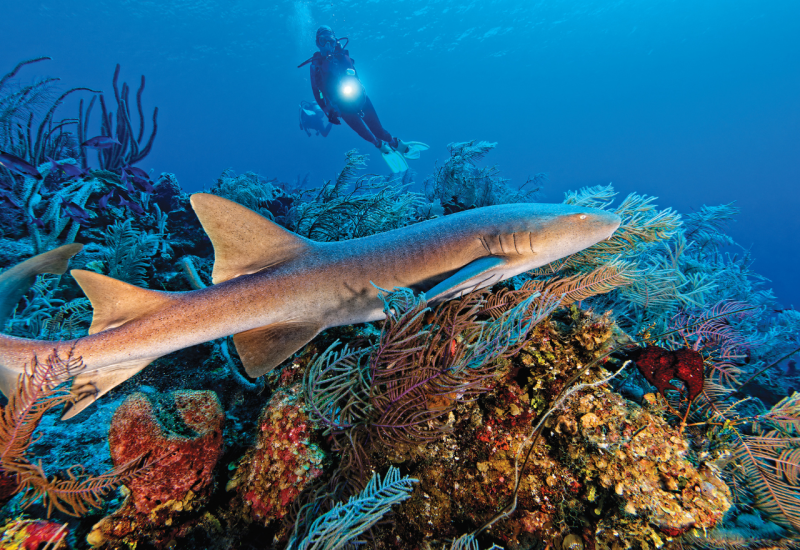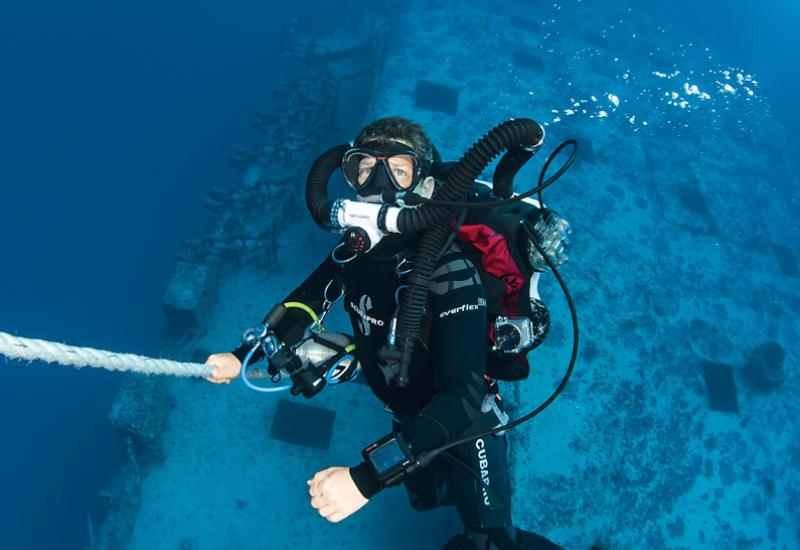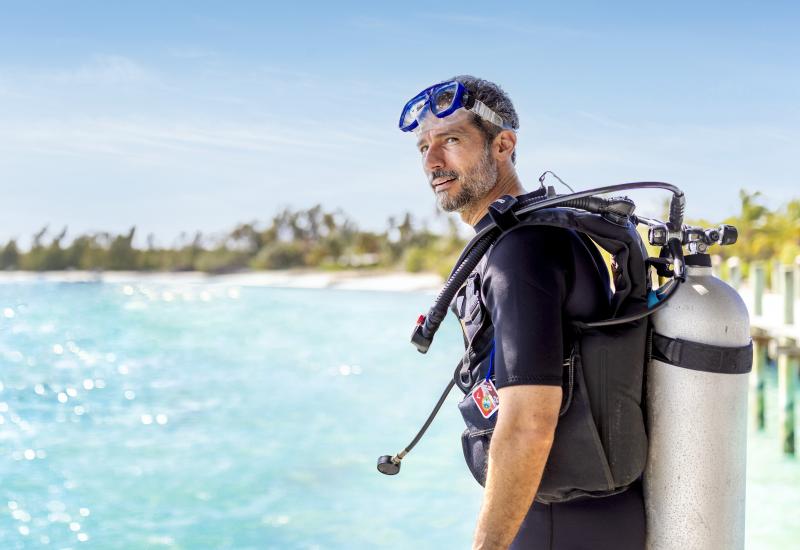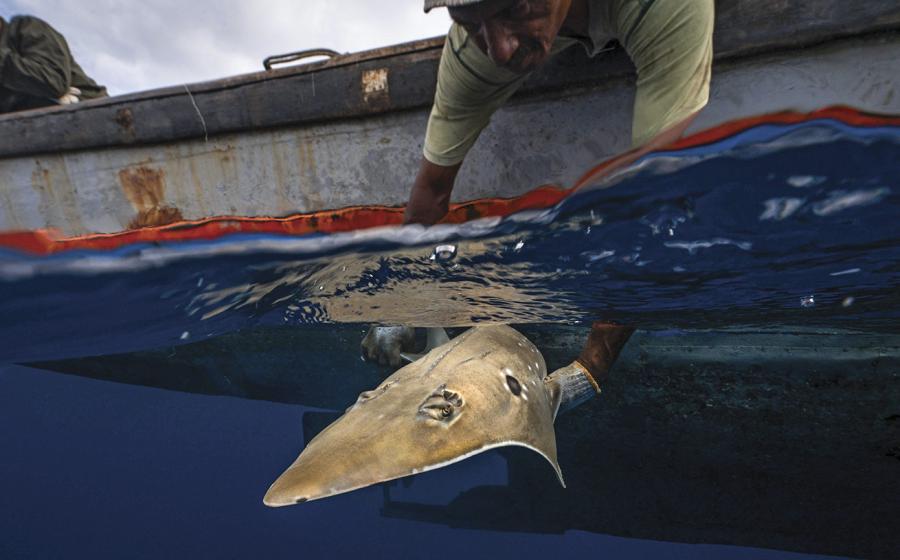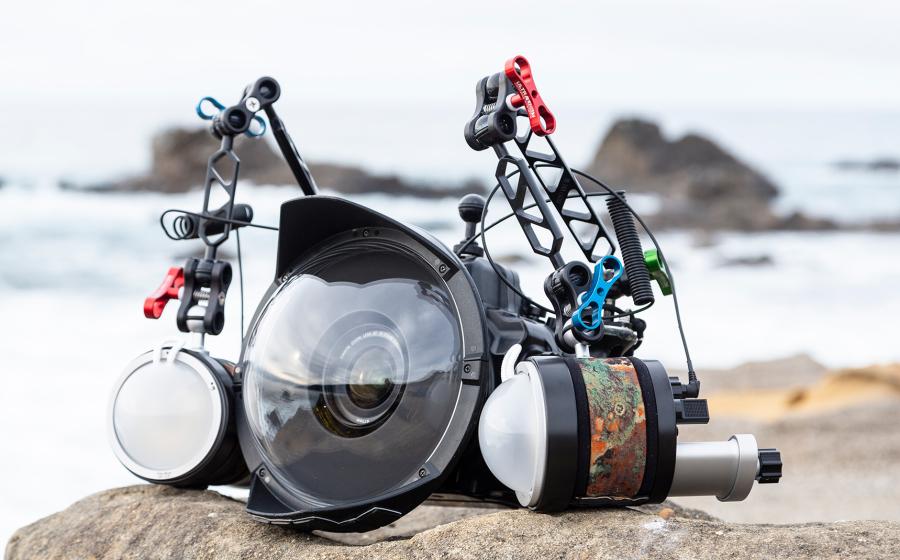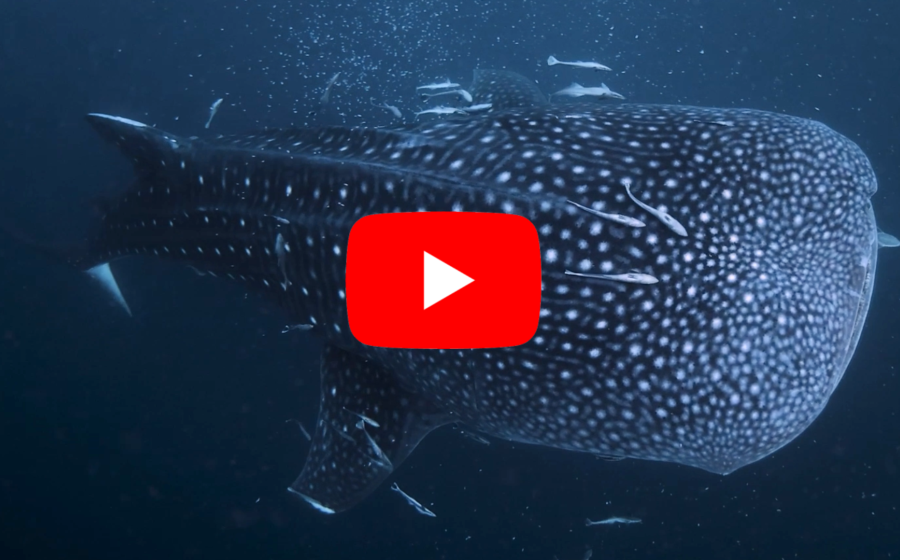The Nitrox Myth?
 |
| Photography by Chris Jaffe |
One of the most prevalent beliefs in recreational diving is that nitrox is used to dive deeper and stay longer. The reality is nitrox is a relatively shallow-water gas that can be used to extend bottom time at moderate depths, but can become toxic at deeper depths. As Divers Alert Network states:
"Today, nitrox mixes are readily available and prepared across a range of concentrations. It has a lot to offer divers, but it isn't magic; rather, it's a useful tool that provides benefits if used correctly. When diving according to air tables or using the air setting on a dive computer, nitrox can reduce decompression stress on a diver. When used with an equivalent air depth, this safety margin is lost, but bottom time can be extended.
"Nitrox is becoming more popular and accessible to recreational divers all the time, but it is not something to be taken lightly. It requires special training to be used properly and safely, so before you dive with it, be sure to get the necessary training and gain the appropriate certification."
What's in a Name?
Nitrox is the general name for any breathing gas with an oxygen content higher than the 21 percent found in air. By upping the oxygen in a diver's tank (recreational nitrox blends contain between 28 percent and 40 percent oxygen — the most popular blends are 32 percent and 36 percent), you reduce the amount of nitrogen and therefore extend bottom times with the same nitrogen exposure as breathing air.
It's a simple idea and it works — at moderate diving depths. The myth that nitrox lets you dive deeper, however, is a dangerous misconception. The problem comes from the fact that oxygen, while vital to keeping divers alive, can become toxic at high pressures. It's a classic case of too much of a good thing.
Too much oxygen at pressure attacks the central nervous system, causing convulsions or seizures, visual distortions, ringing ears, nausea, twitching, irritability and dizziness.
These symptoms occur when the bloodstream is overloaded with oxygen. The oxygen not required for metabolism remains bonded to the hemoglobin or circulates as dissolved gas in the bloodstream. Supersaturated with oxygen, hemoglobin can't transport carbon dioxide to the lungs. As the carbon dioxide and oxygen build up, blood vessels constrict, reducing blood flow to the brain and eventually interfering with the neuromuscular conductors.
Oxygen toxicity hits are very rare in diving, but if they happen under water, they happen fast and are likely to be fatal. Convulsive muscle contractions can lead to embolisms and loss of the regulator can lead to drowning. That's why certified nitrox divers learn to calculate and manage their oxygen exposure.
Do the Math
 |
A diver's oxygen exposure is like a burning candle. You can snuff out the wick with your fingertips without injury, but hold a finger in the flame for a few minutes and serious damage will result.
Oxygen exposure calculations contain two components: the oxygen dose and the time of exposure. The dose is determined by calculating the pressure of oxygen inhaled into the lungs. This is commonly referred to as the partial pressure of oxygen or PPO2.
PPO2 is calculated by multiplying the fraction of oxygen (FO2) in a scuba tank by the pressure at depth in atmospheres absolute (PATA). [PPO2 = FO2 x PATA] You will recall from your entry-level training that the pressure of atmospheres absolute is calculated by dividing the depth in feet seawater (FSW) by 33 and adding 1 surface atmosphere: [PATA = (FSW / 33) + 1]. Since we multiply the fraction of gas by the atmospheres absolute, you can clearly see that the deeper the diver goes, the higher the PPO2; therefore, the shorter the time the diver can stay at a given depth. To use the candle analogy, the hotter we make the flame, the shorter the time required to burn your finger.
Time is the other important factor in calculating oxygen exposure. From research conducted in the 1950s and 1960s by the U.S. Navy and the National Oceanic and Atmospheric Administration (NOAA), we know that a healthy, average diver can tolerate a PPO2 of 1.6 for 45 minutes with reasonable safety (assuming no heavy exertion). Using a typical nitrox mixture of 32 percent oxygen and applying our PPO2 formula, we find that the 1.6 threshold is reached at a depth of 132 feet seawater. This is the diver's maximum operating depth: [5 ATA x .32 = 1.6]. Do the math for 36 percent oxygen and we find 1.6 PPO2 occurs at approximately 114 feet seawater.
As you can see, nitrox is not suited for deeper profiles. It can, however, extend safe bottom times at moderate depths. A comparison of nitrox and air tables shows the most beneficial range for 32 percent nitrox, for example, is between 60 and 120 feet. To read more about oxygen toxicity when using nitrogen as a breathing gas, visit the Divers Alert Network web site.
Is a Lower PPO2 Safer?
 |
Another common nitrox myth is that a PPO2 lower than 1.6 is safer. Training agencies set different PPO2 limits based upon likely profiles. Some technical agencies teach divers how to plan dives with higher PPO2s when the dive calls for it, while more conservative recreational agencies set PPO2 limits as low as 1.4. In reality, a PPO2 is worthless information without the time of exposure. It's true that a lower PPO2 extends the length of allowed exposure during the dive. However, diving to the limits at any PPO2 will expose a diver to the same theoretical risk of an oxygen toxicity hit (see: "Oxygen Exposure Limits" at right). In other words, a diver who follows tables based on a PPO2 of 1.4 for 150 minutes has the same risk as a diver at 1.5 for 120 minutes or a diver at 1.6 for 45 minutes. The effect is similar to diving to the maximum limit of a no-decompression table at any given depth.
Nitrox in Practice
If all this math sounds too complicated — relax. The nitrox diver has a few simple steps and tools that allow him to safely maximize dive time while preventing over-exposure to oxygen.
First, he must analyze his gas to verify the fraction of oxygen, then consult a chart for the maximum safe depth depending on the diver's chosen PPO2. Standard nitrox tables (they work just like air tables) give the diver his extended no-decompression time, or the diver can follow the shorter no-deco times of air tables for a greater margin of safety from DCS. Nitrox divers are also trained to track their cumulative CNS oxygen exposure over the course of each dive and each 24-hour period.
Of course the easiest way to dive nitrox is to input the FO2 into a nitrox dive computer, which automatically tracks and displays all the necessary information. What could be easier than that?

Chris JaffeNitrox tanks
| |Photography by Chris Jaffe|
One of the most prevalent beliefs in recreational diving is that nitrox is used to dive deeper and stay longer. The reality is nitrox is a relatively shallow-water gas that can be used to extend bottom time at moderate depths, but can become toxic at deeper depths. As Divers Alert Network states:
"Today, nitrox mixes are readily available and prepared across a range of concentrations. It has a lot to offer divers, but it isn't magic; rather, it's a useful tool that provides benefits if used correctly. When diving according to air tables or using the air setting on a dive computer, nitrox can reduce decompression stress on a diver. When used with an equivalent air depth, this safety margin is lost, but bottom time can be extended.
"Nitrox is becoming more popular and accessible to recreational divers all the time, but it is not something to be taken lightly. It requires special training to be used properly and safely, so before you dive with it, be sure to get the necessary training and gain the appropriate certification."
What's in a Name?
Nitrox is the general name for any breathing gas with an oxygen content higher than the 21 percent found in air. By upping the oxygen in a diver's tank (recreational nitrox blends contain between 28 percent and 40 percent oxygen — the most popular blends are 32 percent and 36 percent), you reduce the amount of nitrogen and therefore extend bottom times with the same nitrogen exposure as breathing air.
It's a simple idea and it works — at moderate diving depths. The myth that nitrox lets you dive deeper, however, is a dangerous misconception. The problem comes from the fact that oxygen, while vital to keeping divers alive, can become toxic at high pressures. It's a classic case of too much of a good thing.
Too much oxygen at pressure attacks the central nervous system, causing convulsions or seizures, visual distortions, ringing ears, nausea, twitching, irritability and dizziness.
These symptoms occur when the bloodstream is overloaded with oxygen. The oxygen not required for metabolism remains bonded to the hemoglobin or circulates as dissolved gas in the bloodstream. Supersaturated with oxygen, hemoglobin can't transport carbon dioxide to the lungs. As the carbon dioxide and oxygen build up, blood vessels constrict, reducing blood flow to the brain and eventually interfering with the neuromuscular conductors.
Oxygen toxicity hits are very rare in diving, but if they happen under water, they happen fast and are likely to be fatal. Convulsive muscle contractions can lead to embolisms and loss of the regulator can lead to drowning. That's why certified nitrox divers learn to calculate and manage their oxygen exposure.
Do the Math
|
Scuba Diving MagazineEstimated bottom time
|
A diver's oxygen exposure is like a burning candle. You can snuff out the wick with your fingertips without injury, but hold a finger in the flame for a few minutes and serious damage will result.
Oxygen exposure calculations contain two components: the oxygen dose and the time of exposure. The dose is determined by calculating the pressure of oxygen inhaled into the lungs. This is commonly referred to as the partial pressure of oxygen or PPO2.
PPO2 is calculated by multiplying the fraction of oxygen (FO2) in a scuba tank by the pressure at depth in atmospheres absolute (PATA). [PPO2 = FO2 x PATA] You will recall from your entry-level training that the pressure of atmospheres absolute is calculated by dividing the depth in feet seawater (FSW) by 33 and adding 1 surface atmosphere: [PATA = (FSW / 33) + 1]. Since we multiply the fraction of gas by the atmospheres absolute, you can clearly see that the deeper the diver goes, the higher the PPO2; therefore, the shorter the time the diver can stay at a given depth. To use the candle analogy, the hotter we make the flame, the shorter the time required to burn your finger.
Time is the other important factor in calculating oxygen exposure. From research conducted in the 1950s and 1960s by the U.S. Navy and the National Oceanic and Atmospheric Administration (NOAA), we know that a healthy, average diver can tolerate a PPO2 of 1.6 for 45 minutes with reasonable safety (assuming no heavy exertion). Using a typical nitrox mixture of 32 percent oxygen and applying our PPO2 formula, we find that the 1.6 threshold is reached at a depth of 132 feet seawater. This is the diver's maximum operating depth: [5 ATA x .32 = 1.6]. Do the math for 36 percent oxygen and we find 1.6 PPO2 occurs at approximately 114 feet seawater.
As you can see, nitrox is not suited for deeper profiles. It can, however, extend safe bottom times at moderate depths. A comparison of nitrox and air tables shows the most beneficial range for 32 percent nitrox, for example, is between 60 and 120 feet. To read more about oxygen toxicity when using nitrogen as a breathing gas, visit the Divers Alert Network web site.
Is a Lower PPO2 Safer?
|| |---|
|
Scuba Diving MagazineOxygen exposure limits
|
Another common nitrox myth is that a PPO2 lower than 1.6 is safer. Training agencies set different PPO2 limits based upon likely profiles. Some technical agencies teach divers how to plan dives with higher PPO2s when the dive calls for it, while more conservative recreational agencies set PPO2 limits as low as 1.4. In reality, a PPO2 is worthless information without the time of exposure. It's true that a lower PPO2 extends the length of allowed exposure during the dive. However, diving to the limits at any PPO2 will expose a diver to the same theoretical risk of an oxygen toxicity hit (see: "Oxygen Exposure Limits" at right). In other words, a diver who follows tables based on a PPO2 of 1.4 for 150 minutes has the same risk as a diver at 1.5 for 120 minutes or a diver at 1.6 for 45 minutes. The effect is similar to diving to the maximum limit of a no-decompression table at any given depth.
Nitrox in Practice
If all this math sounds too complicated — relax. The nitrox diver has a few simple steps and tools that allow him to safely maximize dive time while preventing over-exposure to oxygen.
First, he must analyze his gas to verify the fraction of oxygen, then consult a chart for the maximum safe depth depending on the diver's chosen PPO2. Standard nitrox tables (they work just like air tables) give the diver his extended no-decompression time, or the diver can follow the shorter no-deco times of air tables for a greater margin of safety from DCS. Nitrox divers are also trained to track their cumulative CNS oxygen exposure over the course of each dive and each 24-hour period.
Of course the easiest way to dive nitrox is to input the FO2 into a nitrox dive computer, which automatically tracks and displays all the necessary information. What could be easier than that?


